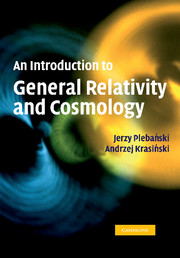Book contents
- Frontmatter
- Contents
- List of figures
- The scope of this text
- Acknowledgements
- 1 How the theory of relativity came into being (a brief historical sketch)
- Part I Elements of differential geometry
- Part II The theory of gravitation
- 12 The Einstein equations and the sources of a gravitational field
- 13 The Maxwell and Einstein–Maxwell equations and the Kaluza–Klein theory
- 14 Spherically symmetric gravitational fields of isolated objects
- 15 Relativistic hydrodynamics and thermodynamics
- 16 Relativistic cosmology I: general geometry
- 17 Relativistic cosmology II: the Robertson–Walker geometry
- 18 Relativistic cosmology III: the Lemaître–Tolman geometry
- 19 Relativistic cosmology IV: generalisations of L–T and related geometries
- 20 The Kerr solution
- 21 Subjects omitted from this book
- References
- Index
16 - Relativistic cosmology I: general geometry
Published online by Cambridge University Press: 01 March 2010
- Frontmatter
- Contents
- List of figures
- The scope of this text
- Acknowledgements
- 1 How the theory of relativity came into being (a brief historical sketch)
- Part I Elements of differential geometry
- Part II The theory of gravitation
- 12 The Einstein equations and the sources of a gravitational field
- 13 The Maxwell and Einstein–Maxwell equations and the Kaluza–Klein theory
- 14 Spherically symmetric gravitational fields of isolated objects
- 15 Relativistic hydrodynamics and thermodynamics
- 16 Relativistic cosmology I: general geometry
- 17 Relativistic cosmology II: the Robertson–Walker geometry
- 18 Relativistic cosmology III: the Lemaître–Tolman geometry
- 19 Relativistic cosmology IV: generalisations of L–T and related geometries
- 20 The Kerr solution
- 21 Subjects omitted from this book
- References
- Index
Summary
A continuous medium as a model of the Universe
When describing the Universe as a whole, one assumes that it is filled with a continuous medium (fluid or gas), whose state can be described by physical fields (scalar fields such as mass density and pressure, vector fields such as the velocity of flow, or tensor fields, e.g. an electromagnetic field). This is a rather crude approximation, since our real Universe has a ‘granular’ structure. Its basic units are stars, and the relevant information from the point of view of observational cosmology is, for example, the number of stars in a given volume rather than the average mass density in that volume. The less-than-perfect adequacy of the fluid approximation is also demonstrated by the fact that the view on which objects should be considered the ‘elementary cells’ of the cosmic fluid has been changing with time. In the times of Hubble (1920s and 1930s), these were the galaxies. In later times, when galaxy clusters and proper motions of galaxies in clusters were observed, the galaxy clusters took over. In still later years, it was found that galaxies and galaxy clusters tend to occupy edges of large volumes of space that are almost empty inside (called voids). According to current beliefs, the elementary units of the Universe should be groups of voids. These changes in the definition of the elementary unit of the Universe were, characteristically, adopted in order to save the assumption of homogeneity and isotropy of the Universe ‘in the large’.
- Type
- Chapter
- Information
- An Introduction to General Relativity and Cosmology , pp. 235 - 260Publisher: Cambridge University PressPrint publication year: 2006



